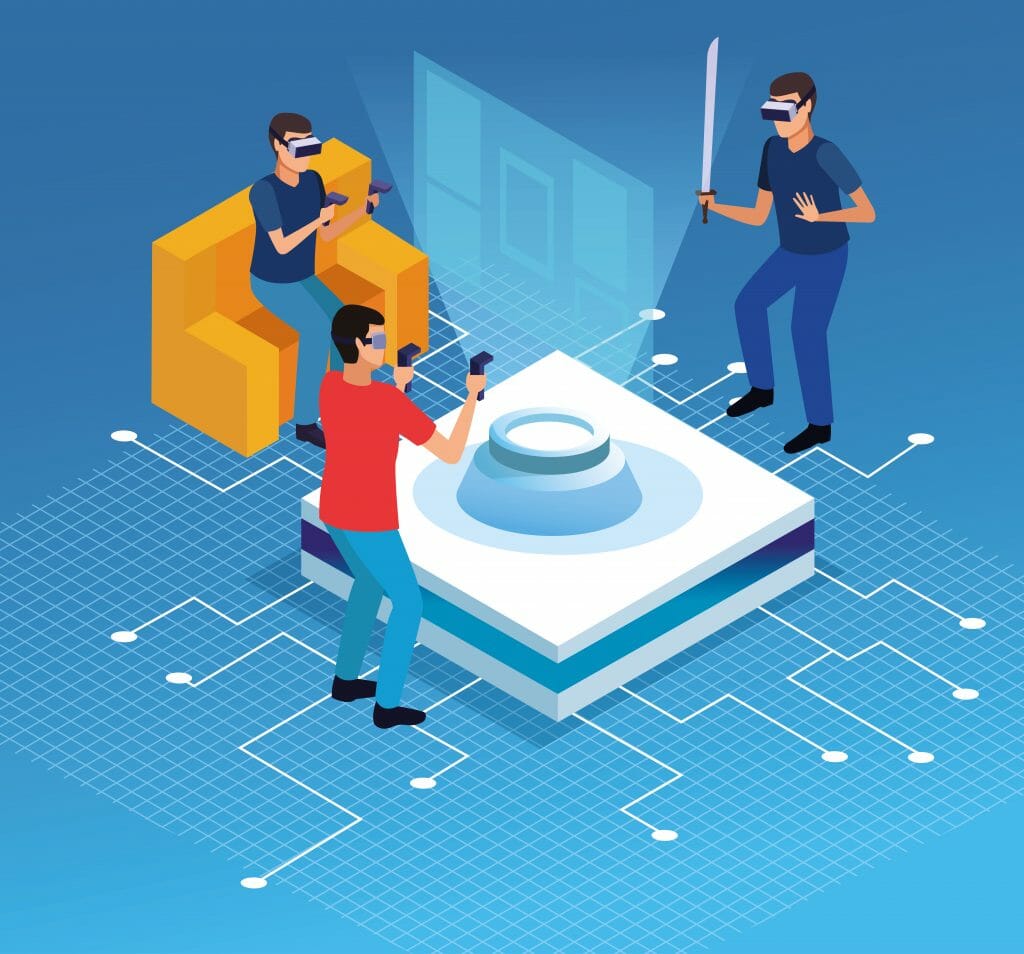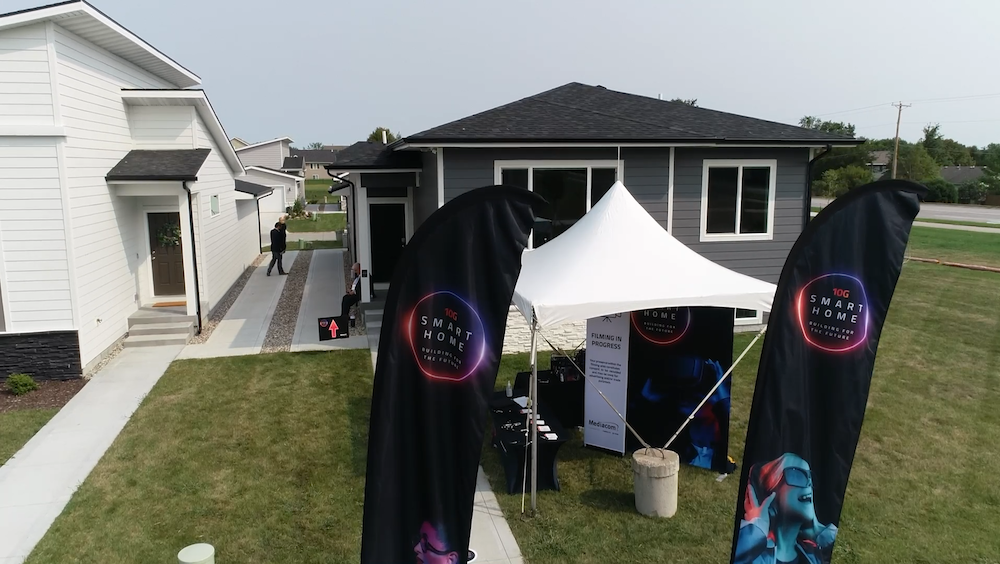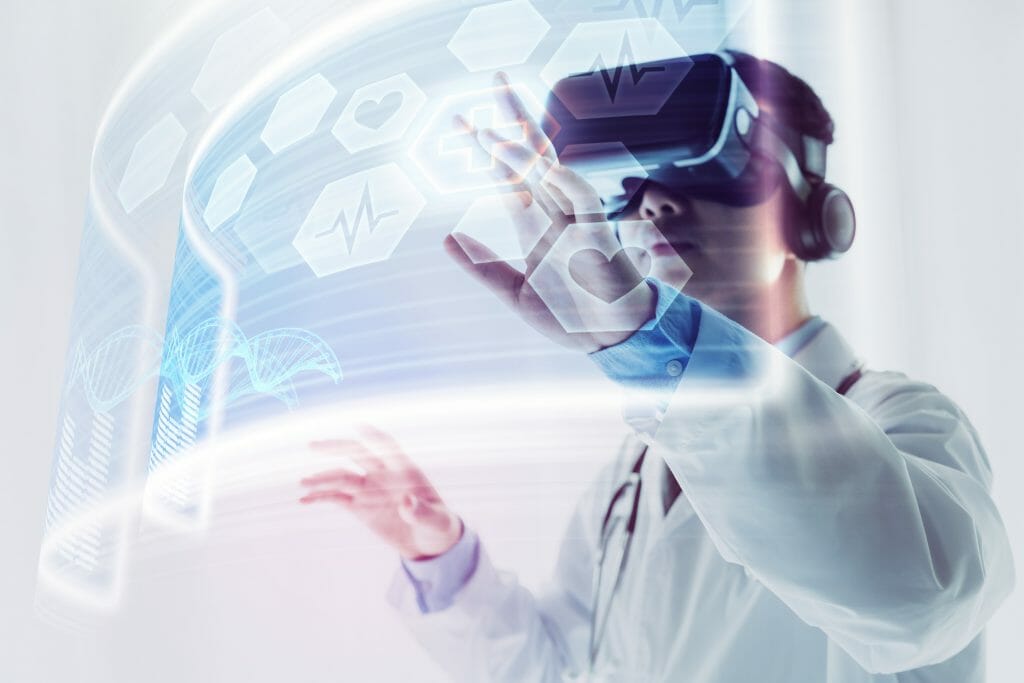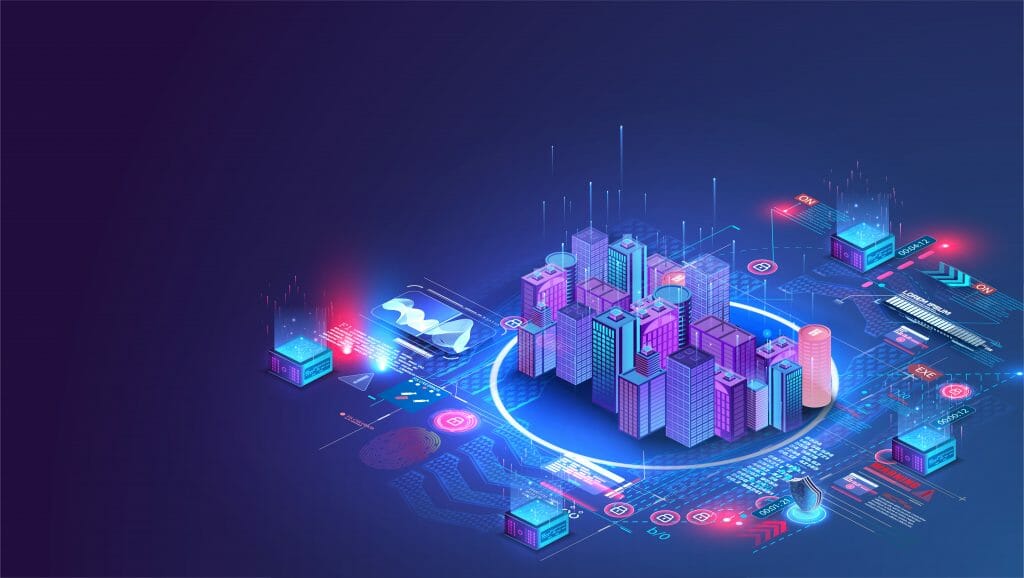10G is the broadband network of the future that will deliver internet speeds of 10 gigabits per second, with the power and capacity to support whatever the future holds.
-is what the 10G website says, which is powered by a few different groups, such as NCTA – The Internet & Television Association; CableLabs, a company that designs broadband to be faster and better; The Society of Cable Telecommunications Engineers (SCTE), who describe themselves as the “premier technology Society in the cable telecommunications industry;” and GIGA Europe, who says they bring together “private operators who build, operate and invest in the gigabit communications networks that enable Europe’s digital connectivity.” GIGA Europe has partners of its own, including Comcast, WarnerMedia, AMC Networks International, TDC Group, Virgin Media, Vodafone, CableNet, and many more.
From 1 Gig To 10
According to data from a CableLabs’ analysis and FFC Form data, 86% of Americans have access to just one gigabit.
A gigabit is similar but different to the more commonly known gigabyte. ITX Design explains the distinction:
A gigabit is very similar to a gigabyte, since they both represent a unit of measurement for digital storage space. However, the difference is found in the byte vs. bit. A gigabit represents ten to the ninth power on the International System of Units (SI). One gigabit is equal to 1,000,000,000 bits.
The symbol of a gigabit is G. However, a bit is eight times smaller than a byte, which means a gigabit is eight times smaller than a gigabyte.
To clarify any potential confusion, the G in 5G represents “generation;” whereas the G in 10G is reference to gigabits.
When the lockdowns began over a year ago, internet and streaming services saw a massive rise in traffic. The current system was able to handle the influx but furthers the need for faster and more suitable structures to sustain the future.
So why the need, asks the 10G website?
Citing data from Cisco Visual Networking Index (VNI), the 10G website says that video streaming traffic will quadruple from 2018 to 2022 – estimated to make up at least 82% internet traffic. Data from Cisco’s Annual Internet Report, it is forecast that 2023 will see over 29 billion smart connected devices, which is up from 18.4 billion in 2018.
Additionally,
With virtual reality (VR) and augmented reality (AR) taking off, internet traffic is set to skyrocket. In 2022, VR and AR will make up 12 times more traffic than in 2017, totaling 4 exabytes per month. Gaming experiences are also getting richer with high-definition displays, and growing popularity of connected multiplayer gamers. The internet traffic from gaming is expected to be 9 times greater in 2022 than it was in 2017.
Citing statistics from Cisco Visual Networking Index (VNI)
According to the site, we have even more devices therefore leading to more much of a reliance on connectivity. Instead of phone calls, we video chat. Instead of playing music with our own devices, we get them from the internet. We are playing games with others all across the world at any given moment. Because of these increasing social changes, it is projected that internet traffic will be greater than the internet’s launch in 1984 through 2016 combined – estimating that roughly 28 billion devices will be online in 2022, according to Cisco.
These changes in society have prompted an upgrade in the current system to make the user’s experience much faster and connectivity more viable.
So then how will it be accomplished?
Deployment of several types of DOCSIS (Data Over Cable Service Interface Specification) technologies will improve performance of our existing networks, without having to update the infrastructure.
This will lead to a spike of 50% more transmission speed of data, facilitating faster and improved quality of video conferencing, live gaming, virtual reality, and other connected devices.
The improved plexus’ will be able to support better symmetrical upload and download speeds, so fast, latency will be basically become nonexistent slashing response times to 1 millisecond.
This will be supported by,
Multiple fiber optic technologies will enable the current cable infrastructure to manage increased internet traffic far into the future.
Coherent Optics enable a single fiber to handle signals moving in both directions, saving energy and cost, while doubling capacity.
This uninterrupted connectivity will be made possible in improvements to the Wi-Fi systems so consumers will not experience any glitching, buffering, or lagging.
“New practices” will handle data from Wi-Fi routers to support in protective network upkeep to detect and resolve any problems in the connection. Simultaneously, dual channel Wi-Fi will mollify any interruptions caused by network congestion. Because of this, there will be far fewer connection errors, as issues will be detected before they occur.
These new and improved systems will be far more superior in security, as the management system will be able to identify and organize connected devices to isolate and threats to the network that cause damage to itself.
On top of all this, the 10G website says this broadband technology will help facilitate the wireless 5G systems – as the strain on the network will be lessened as calls will be transmitted utilizing wireless signals being only sent to two end points.
The website goes onto to say that 10G will power the “4th Industrial Revolution” that will result in video streaming with super high resolution with zero lag to millions, insane video game graphics and receptivity, immersive education and telework that includes holodecks, video walls and head-mounted displays; travel expenses will be significantly lessened and replaced with virtual reality – a hologram of sorts, allowing for video chatting between family and friends all the more immersive and enhanced. Additionally, healthcare will see benefits from remote diagnostics and “high capacity medical radiology, improving care while removing the inconvenience of travelling for care.”
According to the website, a total 676,000 jobs are estimated to be created across a few different subcategories. 10G productions is estimated to add $330 billion in GDP.
A Platform For 5G Synchronization
On April 29, 2020, an article originally appearing on CableLab’s website was uploaded on the 10G website discussing how the 10G networks would be integrated with the 5G systems. Here is that report reproduced:
Cable service providers operate an extensive hybrid fiber coax (HFC) infrastructure to serve residential and business fixed broadband. In recent weeks, the world witnessed how cable networks around the globe have withstood the test of a dramatic surge in capacity demand due to the work-from-home (WFH) and other xFH practices induced by COVID-19 pandemic and are holding up extremely well.
As the economy opens again and 5G deployments resume, a large part of the time lost due to the COVID-19 pandemic can be regained by leveraging the extensive wireline networks to transport the mobile 5G traffic, be it fronthaul, midhaul or backhaul (collectively termed “xhaul”) between the radio units (RUs) or Base Stations (BSs) and the RAN Infrastructure. A critical impediment that stood in the way of leveraging the ubiquitous HFC infrastructure was the inability to provide timing and synchronization to the radio units which is crucial to their operation.
For nearly two years, the CableLabs Mobile Xhaul vendor and operator team has been working on equipping the DOCSIS® technology to provide better xhaul for mobile traffic.
Today, we are happy to announce the publication of the first release of the Synchronization Techniques for DOCSIS Technology Specification. When coupled with the Low Latency Xhaul Specification (LLX) standardized last year which specifies requirements to reduce the latency on the DOCSIS network for mobile traffic. The two together provide the performance needed for DOCSIS network to xhaul mobile traffic. The ubiquity of the HFC plant will greatly assist the economic and timely deployment of these new 5G radios.
The mobile network is synchronous by design and require the sharing of a common clock. This is achieved in practice by means of the radios and “their controllers” connecting to the Global Navigation Satellite System (GNSS). This works well for outdoor macro deployments. For small cell deployments, especially indoors, more often than not GPS signals are either not available or not economical. Instead, an equivalent global clock signal is transported over the IP network using precision time protocol (PTP), specified in the IEEE 1588-2008 family of specifications.
Transporting PTP over the DOCSIS network is particularly challenging due to the asymmetrical nature of the DOCSIS network. Leveraging the DOCSIS Time Protocol (DTP) to address the asymmetry issue offers a practical solution. A high-level architecture of the solution framework is illustrated in the figure below (technical details can be obtained in this SCTE white paper). DTP was invented back in 2011 and incorporated into the DOCSIS 3.1 specifications in 2013. In the newly issued SYNC specification, the Mobile Xhaul team updated the DTP profiles, defined timing system architectures and specified requirements on the DOCSIS network equipment to make PTP work end-to-end. As a result, the DOCSIS specification when bolstered with the newly issued SYNC spec and the LLX spec, is capable to support the LTE and 5G timing requirements.

The Mobile Xhaul team invites cable and mobile operators as well as vendors to provide input to these latest set of specifications. Several HFC equipment vendors have already demonstrated the feasibility of DTP in various proof of concept (PoC) implementations. In the upcoming months, our team will complete additional requirements and timing architectures.
Soon, cable MSOs will be upgrading their HFC plants to the distributed access architecture (DAA). DAA nodes are already PTP-compatible, as PTP is needed for the R-PHY device and the CMTS core to be on the same timing island. The MSOs and cable equipment vendors are better off designing their new network architectures with mobile requirements in mind and ensure that the DAA nodes can support the 1.5µs of end-to-end timing requirement needed for LTE and majority of the 5G deployments as specified in the SYNC spec.
We are excited to offer the ability of the DOCSIS technology to provide reliable and precision timing services. This will aid the ubiquitous HFC wireline network to become an obvious choice for the mobile operators as a low CAPEX and fast-to-deployment xhaul solution. We are working hard to converge the 10G and the 5G technologies, and SYNC is one of the areas that has come to fruition.
We acknowledge the tremendous efforts the Mobile Xhaul team in driving these specifications to a timely publication, specifically those who did heavy lifting in the SYNC spec: John Chapman (Cisco), Elias Chavarria Reyes (Cisco), Peter Meyer (Microchip) and Yair Neugeboren (CommScope).
The Future Of Entertainment
Because of the lockdowns and Covid-related restrictions surrounding large gatherings, the Comic-Con event was forced to go solely online last year. It was then dubbed “Comic-Con@Home,” and panelists of technology experts in the fields associated with sports, music, and education met to discuss the future of entertainment.
The first thing we’ve seen happen [in the music world] and which has been a big thing given the pandemic, is livestreaming. But now it has become a big thing that I think will carry on past the pandemic. I think before, people weren’t used to livestreaming because they were actually going to a lot of shows.
Phil Quist. A music agent with Creative Artists Agency.
Since the start of the pandemonium a year ago Quist says he has had clients performing livestreams to patrons all over the world, selling millions of tickets in the process – in some cases even more than physical events.
There is money to be made there, but also the amount of interactivity you can have with [a livestream]—you can be in a big chat room with people all over the world. You can be on screen and interact with the artist. It’s a way to build your fan base [as the artist] not just in respective cities but in places you wouldn’t necessarily be going to.
Phil Quist
Quist also sees multiple applications of the future of musical education that will be designed to help the youthful develop more music interest that might have been previously constrained by travel and location to get in-person lessons.
Imagine being able to see your teacher on your computer and have a digital keyboard pop up
Phil Quist
In terms of sports, agent Leigh Steinberg, the muse behind “Jerry Maguire,” has been working on ways to enhance the viewer’s experience.
The next generation of millennials, sitting in a static sports stadium for hours, probably doesn’t work well for them.
Leigh Steinberg
Steinberg and his team have been developing an app that will allow fans to interact with other fans, help take command of a coach’s play-calling decision, or order snacks from concessions – all while sitting in their stadium seats. This is all being designed to keep the younger generations much more engaged and interacted with the sport.
Ted Schilowitz, a futurist for Paramount Pictures, described an even more bolder and interactive way to watch and participate in sporting and gaming. He envisions people being to put on a VR headset and play a game such as golf or baseball without partners or team members physically present. Or the potential for one’s own highly detailed avatars to virtually participate in dances or music festivals.

In the next 5-7 years, you’re going to see multiple waves of the sophistication of these devices [ingrained] into mass consumer behavior.
We are entering the age of what I like to call the ‘screenless screen. The next wave of what a screen will be will not look anything like the screens that exist today. It will be a virtual layer on reality that will feel transparent to you.
This is not science fiction, this is science reality. It’s really happening. We are all going to have a device that is going to get you into the screenless screen within the next few years.
Ted Schilowitz
The 10G Smart Homes And Suburbs
On September 17, 2020, MediaCom Communications, in association with CableLabs and NCTA, gave the public a tour of a trial run for the future of houses integrated with the 10G network – referred to as the Mediacom 10G Smart Home.
The event took place in Ames, Iowa

Mediacom worked with CommScope and other leading tech companies to move 10G from a laboratory concept to a real world consumer experience. Similar to our rapid deployment of 1-Gig across our national network in 2017, the beauty of 10G is that it’s extremely scalable within our existing network infrastructure. This means the compelling demos we showcased today in Ames will be part of the near future for Mediacom customers.
JR Walden. Mediacom CTO
Mediacom installed over 70 internet-enabled smart devices in the home to demonstrate the ubiquitous and simultaneous functionality of the 10G network. ‘Many of these were bandwidth intensive applications including stunning footage shot by Mystery Box in 8K 60fps, encoded at a high bit rate and streamed over a Vecima CDN server to a Samsung QLED Smart 8K ultra-high definition television inside the home,’ according to the website report.
Some of these emerging technologies were once thought of as science fiction, but now they’re on the cusp of reality. What Mediacom was able to do with this demonstration was give consumers a glimpse of the unbounded innovation the 10G platform will drive in the years ahead.
Phil McKinney. CableLabs CEO
Experts from different fields were there to demonstrate some of their technologies all working in unison with the system and other applications in the home.
This included:
- Alarm.com – demonstrated their award-winning autonomous home functionality greatly boosting and augmenting security and efficiency.
- CableLabs – shared “holographic 3D images through a Looking Glass light field display that could be seen without the need for glasses or headwear.”
- Healium – provided virtual and augmented reality systems to improvements in mental fitness.
- Iowa Chill – delved into the permutation of the rapidly growing eSports revolution.
- UnityPoint Health – “connected patients with doctors using the latest telemedicine solutions.”
- Zestful Kitchen – concocted masterpiece recipes utilizing the most state-of-the-art kitchen appliances.
‘CommScope provided the broadband architecture and network solutions to connect these applications together and a 10G performance app illustrating how bandwidth was being used in the smart home,’ the article stated.
The cable industry’s commitment to bringing world class technology to American homes and businesses was on full display today in Iowa. Mediacom’s groundbreaking 10G field trial is the latest example that our member companies are delivering an exceptional national infrastructure that will inspire American ingenuity for generations to come.
Michael Powell. President and CEO of NCTA
You can see the smart home in action in this short video. The smart home even had its own robotic dog.
Hospital In The Home
Due to Covid-19 related restrictions and lockdowns, doctor visits were practically put on hold and still are in many parts of the world. This has led to a drastic rise in telecommunications with doctors to be diagnosed and prescribed treatments without having to leave the home.
With 10G integrated networks, this experience will now become even easier and accessible than before.
The 10G website says that the patient’s home will be able to support blood pressure tests, to track and monitor a person’s everyday health and vital signs, to look for signs of any serious ailments. The experience will be seamless.
Some of these functions were tested at the smart home in Ames, Iowa.
The personalized and connected health care company, Trapollo, is developing an app available on smart devices that allows for full monitorization for the healthcare provider, so patients can receive the proper medical care and service required. This will be accomplish via a two-way conversation with the patient and the physician.
Now with smart homes being a part of the healthcare environment, the concept of creating the ‘Smart Healthy Home,’ as I like to call them, is here. There is a great amount of flexibility in what we can do both as a patient and as a caregiver.
Mike Braham. Trapollo’s chief executive officer

The 10G website says another company is helping to develop services to be integrated with the network – ‘Kinsa has developed an early warning system to detect and respond to contagious illness. Kinsa utilizes a network of millions of smart thermometers to track the spread of illness in real-time and forecast future outbreaks. The company has already had success predicting flu incidents. With the right combination of broadband infrastructure and telehealth innovation, Kinsa CEO and Co-Founder, Dr. Inder Singh, believes that the technology could have the power to predict – and prevent – the next pandemic.’
The power of the networks is amazing. If we can get communication with someone at the earliest sign or symptom, or when they first got sick, we could also see whether or when symptoms are starting and how fast they are spreading.
Economic Boost And Creation Of The Smart Cities
As mentioned in the beginning of this report, hundreds of thousands of jobs are estimated to be created with billions of dollars in revenue.
According to a report published on October 7th of this year, it is estimated that the rollout of the 10G network will cost $80 billion in direct network investment, and another $45 billion for intermediate goods and services.
The analysis estimates an additional “spillover” of 1.5 million jobs created for the next generation service sector jobs, including the construction and management of “smart homes,” “smart cities,” and “smart industries,” which even includes agricultural advancements.
The report lists some of the fields in development or integration, some that have already been discussed in more detail already from other articles. However, they do describe some of the innovations that are in the process of development.
One of these innovations is what they refer to as “precision agriculture.”
A corn grower in Iowa, using hundreds of wireless sensors across a farm all interacting in real-time via 10G backhaul connections with dozens of apps and services (from weather modeling tools to market pricing models) on servers all across the globe, will get precise instructions on exactly which rows and individual plants need water, nutrients, or pesticides in a given moment – allowing them to increase yields and revenue while saving precious time and resources.
They also explain the benefits of the 10G plexus integration in “supply chain logistics.”
10G networks will securely link inventory databases, warehouse robots, customs systems, trucking route optimization tools, and fuel price data, letting a manufacturer in Ohio, for example, instantly and effortlessly find the fastest, least-expensive, and least-emitting shipping option to deliver its products to a customer in Europe or Asia.

10G integration will result in improved and smarter manufacturing.
Sensors embedded in manufacturing equipment, providing real-time data from production lines with cloud-based machine learning programs over 10G technology, can predict manufacturing problems in real-time thereby increasing production and reducing waste. This translates to larger margins for manufacturers, and a safer workplace for employees.
And lastly, 10G installment will help power and run the “smart cities.”
10G networks will enable “smartcities” interconnecting and backhauling the huge volumes of data generated by the wireless sensors and smart systems. For example, traffic camera imagery can communicate directly with intelligent traffic lights to optimize timing, getting commuters home faster and reducing the economic and environmental costs of traffic. Sensors will vigilantly monitor the integrity of roads, bridges, and transit infrastructure – communicating troves of data in real-time to intelligent systems that can spot failures and safety issues before they even happen.

Whatever It Takes
This is the slogan the partners creating 10G say. Whatever it takes to get the network installed and implemented, they are going to do it. In a report released in July of this year, the 10G website stated: “PANDEMIC OR NOT, 10G IS COMING.”
Nothing will be getting in their way. 10G is the wave of the future and it is here to stay whether you like the idea or not. Whatever it takes.
AUTHOR COMMENTARY
The 10G integration was a missing link that we have not reported on until now. For that matter, so many people have never even heard of this. I accidently stumbled upon this and I started to do more digging: and this confirms so much of what The WinePress has been harping on.
We have been warning of the coming future and agenda to create smart cities and smart homes, a future that is not very far away. In light of this information, it explains how they will be accomplished and sustained. Of course there will be subsequent upgrades from there, but this major piece of the puzzle explains how it will be accomplished.
Agenda 2030: You’ll Own Nothing And Be Happy
Vehicle Giant Toyota Building A Smart City In Japan
U.S. Department Of Energy Unveils New Power Grid Project
The Mass Exodus From The Churches
Walmart To Fulfill Orders With Robots In Automated Local Fulfillment Centers
I have mentioned before in some of our reports on the concerning health effects that 5G causes. What many do no realize is that the 5G towers put in place are not fully cranked up all the way. That is probably due to the lack of the 10G integration that is still being installed. I can only imagine what the health effects this will now cause.
Also, knowing what 6G is, it makes me wonder when the cybernetic integration will begin on man. 10G never really alludes to any of this, but WinePress readers know it is coming.
Based on the predictive programming we have seen, and the support from the scriptures, that is just another catalyst to usher in the antichrist system.
[16] And he causeth all, both small and great, rich and poor, free and bond, to receive a mark in their right hand, or in their foreheads: [17] And that no man might buy or sell, save he that had the mark, or the name of the beast, or the number of his name. [18] Here is wisdom. Let him that hath understanding count the number of the beast: for it is the number of a man; and his number is Six hundred threescore and six.Revelation 13:16-18
To do a bit of promotion here, this is why you read and help support The WinePress. We are doing the best that we can to warn you of what is to come and how to prepare. The information and facts we bring out can be found from no other Christian outlet. We say that, not to vaunt ourselves, but to assert that we want to warn and inform the masses as to what is going on. Other Christian outlets will not tell you this stuff. And when they do, they water it down with their own spin on it, and release the information after it is far too late.
The simple believeth every word: but the prudent man looketh well to his going.
Proverbs 14:15
Leave your thoughts in the comments below.
The WinePress needs your support! If God has laid it on your heart to want to contribute, please prayerfully consider donating to this ministry. If you cannot gift a monetary donation, then please donate your fervent prayers to keep this ministry going! Thank you and may God bless you.








A future like that is a nightmare, for one I don’t want to live in it “whatever it takes” 😛 Hopefully the Lord calls us before all this starts being heavily implemented.
Amazing content! God bless!!!!!
Valuable info. Lucky me I found your web site by accident, and I’m shocked why this accident didn’t happened earlier! I bookmarked it.
Thanks for ones marvelous posting! I quite enjoyed reading it, you may be a great author.I will ensure that I bookmark your blog and may come back at some point. I want to encourage you continue your great posts, have a nice afternoon!
Appreciating the dedication you put into your website and in depth information you present. It’s good to come across a blog every once in a while that isn’t the same unwanted rehashed information. Fantastic read! I’ve bookmarked your site and I’m adding your RSS feeds to my Google account.
Woh I enjoy your blog posts, saved to my bookmarks! .